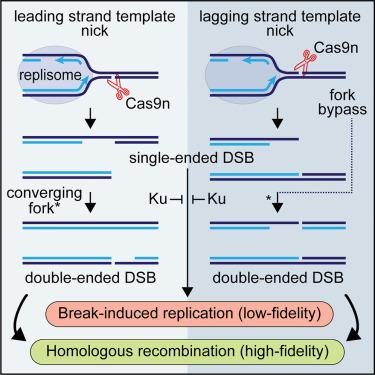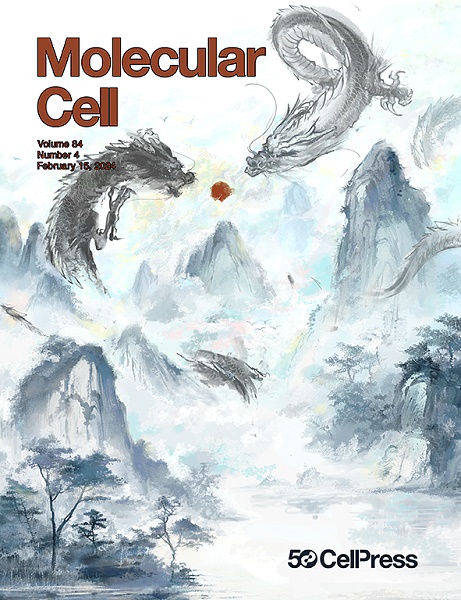前向链和滞后链模板上的 DNA 缺口都能引发断裂诱导复制
IF 14.5
1区 生物学
Q1 BIOCHEMISTRY & MOLECULAR BIOLOGY
引用次数: 0
摘要
复制叉与未修复的DNA单链断裂(SSB)相遇可产生单端和双端双链断裂(seDSB和deDSB)。seDSB可通过断裂诱导复制(BIR)修复,BIR是一种高度致突变的途径,被认为是导致癌症发生的许多突变和基因组重排的原因。然而,BIR 的部署频率及其由前导和滞后模板链 SSB 触发的能力尚不清楚。利用由包括CRISPR-Cas9缺口酶(Cas9n)在内的缺口酶产生的位点和链特异性SSB,我们证明裂殖酵母中的前导和滞后模板链SSB通常会转化为deDSB,并通过同源重组进行修复。然而,这两种类型的 SSB 也能引发 BIR,而且当叉汇聚延迟和非同源末端连接蛋白 Ku70 被删除时,这些事件的发生频率会增加。本文章由计算机程序翻译,如有差异,请以英文原文为准。

DNA nicks in both leading and lagging strand templates can trigger break-induced replication
Encounters between replication forks and unrepaired DNA single-strand breaks (SSBs) can generate both single-ended and double-ended double-strand breaks (seDSBs and deDSBs). seDSBs can be repaired by break-induced replication (BIR), which is a highly mutagenic pathway that is thought to be responsible for many of the mutations and genome rearrangements that drive cancer development. However, the frequency of BIR’s deployment and its ability to be triggered by both leading and lagging template strand SSBs were unclear. Using site- and strand-specific SSBs generated by nicking enzymes, including CRISPR-Cas9 nickase (Cas9n), we demonstrate that leading and lagging template strand SSBs in fission yeast are typically converted into deDSBs that are repaired by homologous recombination. However, both types of SSBs can also trigger BIR, and the frequency of these events increases when fork convergence is delayed and the non-homologous end joining protein Ku70 is deleted.
求助全文
通过发布文献求助,成功后即可免费获取论文全文。
去求助
来源期刊

Molecular Cell
生物-生化与分子生物学
CiteScore
26.00
自引率
3.80%
发文量
389
审稿时长
1 months
期刊介绍:
Molecular Cell is a companion to Cell, the leading journal of biology and the highest-impact journal in the world. Launched in December 1997 and published monthly. Molecular Cell is dedicated to publishing cutting-edge research in molecular biology, focusing on fundamental cellular processes. The journal encompasses a wide range of topics, including DNA replication, recombination, and repair; Chromatin biology and genome organization; Transcription; RNA processing and decay; Non-coding RNA function; Translation; Protein folding, modification, and quality control; Signal transduction pathways; Cell cycle and checkpoints; Cell death; Autophagy; Metabolism.
 求助内容:
求助内容: 应助结果提醒方式:
应助结果提醒方式:


